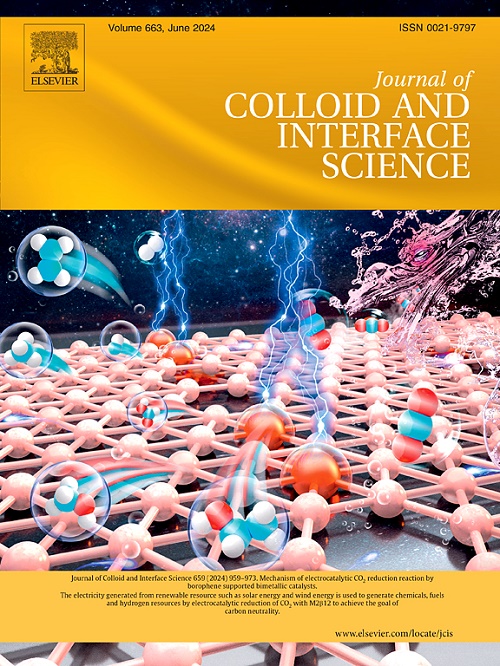TiO2纳米片上配体介导的银与光催化析氢活性的关系。
IF 9.7
1区 化学
Q1 CHEMISTRY, PHYSICAL
引用次数: 0
摘要
负载金属物质的金属氧化物光催化剂在光催化中具有十分重要的意义。金属种类的物理化学状态以及金属种类与载体的相互作用决定了异质界面间载流子的转移,这对光催化活性有重要影响。在这里,我们用配体介导的方法制备了由不同Ag物种修饰的锐钛矿型TiO2纳米片(TIO),包括单原子、簇和纳米颗粒。采用高角环形暗场扫描透射电子显微镜(HAADF-STEM)和高分辨率透射电子显微镜(HRTEM)验证了不同形态Ag在TIO表面的存在;电子顺磁共振(EPR)和漫反射红外傅立叶变换光谱(DRIFTS)证实了银在不同存在状态下引起的异质界面和载流子转移通道电子性质的变化;x射线吸收精细结构(XAFS)对银的价态、配位环境和电荷密度进行了深度区分。令人感兴趣的是,光催化析氢活性呈现驼峰状,这可以归因于不同状态下银的物理化学性质的变化。此外,密度泛函理论(DFT)计算和实验结果相结合表明,Ag单原子是水分裂的活性位点,而Ag簇倾向于吸引电子并提高电荷分离效率。本研究深入研究了锚定在光催化剂表面的金属的微观变化与其光催化性能之间的关系,为通过调整光催化剂表面金属的存在状态来实现精确的表面工程和性能优化提供了进一步的见解。本文章由计算机程序翻译,如有差异,请以英文原文为准。

Correlation between ligand-mediated silver species on TiO2 nanosheet with the photocatalytic hydrogen evolution activities
Metal oxide photocatalysts loaded with metal species are extremely important in photocatalysis. The physicochemical states of metal species, as well as the interaction between metal species and support, determine the transfer of charge carriers between the heterointerface, which has a significant impact on photocatalytic activity. Here, we prepared anatase TiO2 nanosheets (TIO) modified with different Ag species, including single atoms, clusters, and nanoparticles, using a ligand-mediated method. The existence of different forms of Ag species on TIO was verified by high-angle annular dark field scanning transmission electron microscope (HAADF-STEM) and high-resolution transmission electron microscope (HRTEM); Electron paramagnetic resonance (EPR) and diffuse reflectance infrared Fourier transform spectroscopy (DRIFTS) confirmed the changed electronic properties in heterointerface and charge carrier transfer channels caused by the Ag species in different existence states; X-ray absorption fine structure (XAFS) in depth differentiated the valence states, coordination environments, and charge densities of Ag species. It is intriguing that the photocatalytic hydrogen evolution activity exhibits a hump shape, which can be attributed to the changes in the physicochemical properties of silver species in different states. In addition, the combination of density functional theory (DFT) calculations and experimental results demonstrated that the Ag single atom acted as an active site for water splitting, while the Ag cluster tended to attract electrons and promoted charge separation efficiency. This work delves into the relationship between the microscopic changes of metal species anchored on the surface of photocatalysts and their photocatalytic performance, providing further insights into precise surface engineering and performance optimization by adjusting the metal presence state on the photocatalyst surface.
求助全文
通过发布文献求助,成功后即可免费获取论文全文。
去求助
来源期刊
CiteScore
16.10
自引率
7.10%
发文量
2568
审稿时长
2 months
期刊介绍:
The Journal of Colloid and Interface Science publishes original research findings on the fundamental principles of colloid and interface science, as well as innovative applications in various fields. The criteria for publication include impact, quality, novelty, and originality.
Emphasis:
The journal emphasizes fundamental scientific innovation within the following categories:
A.Colloidal Materials and Nanomaterials
B.Soft Colloidal and Self-Assembly Systems
C.Adsorption, Catalysis, and Electrochemistry
D.Interfacial Processes, Capillarity, and Wetting
E.Biomaterials and Nanomedicine
F.Energy Conversion and Storage, and Environmental Technologies

 求助内容:
求助内容: 应助结果提醒方式:
应助结果提醒方式:


